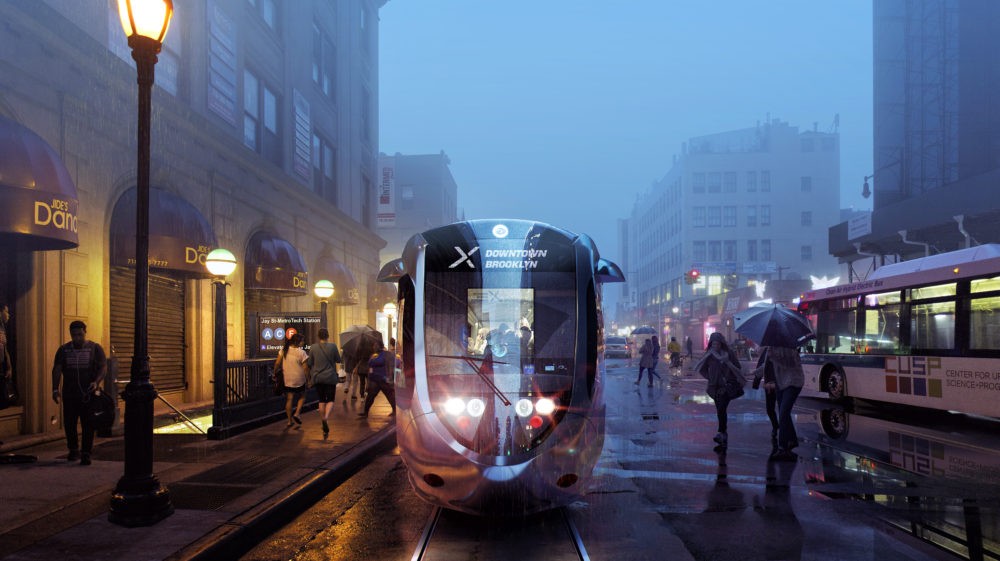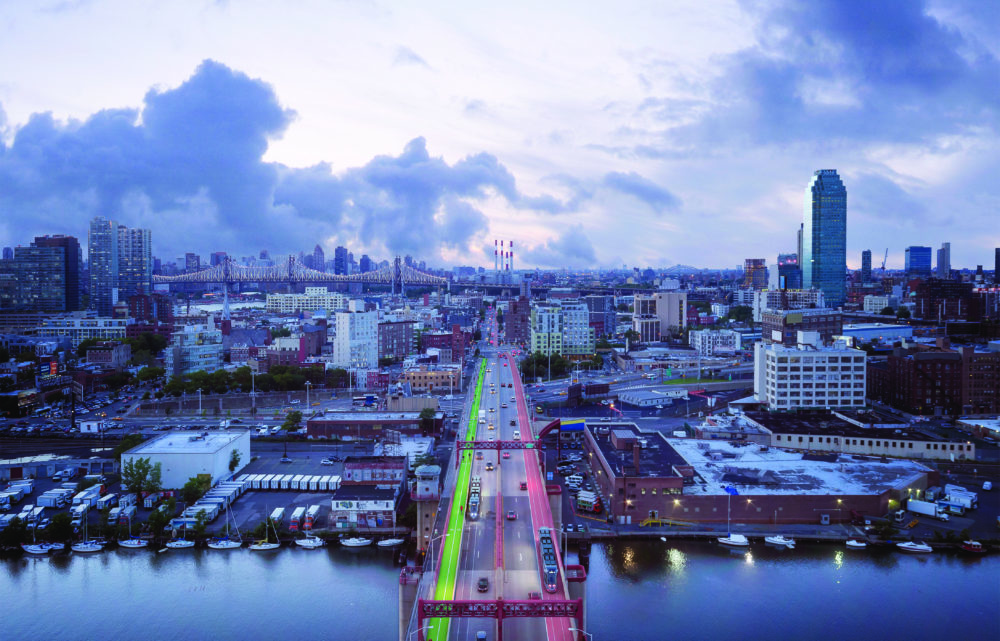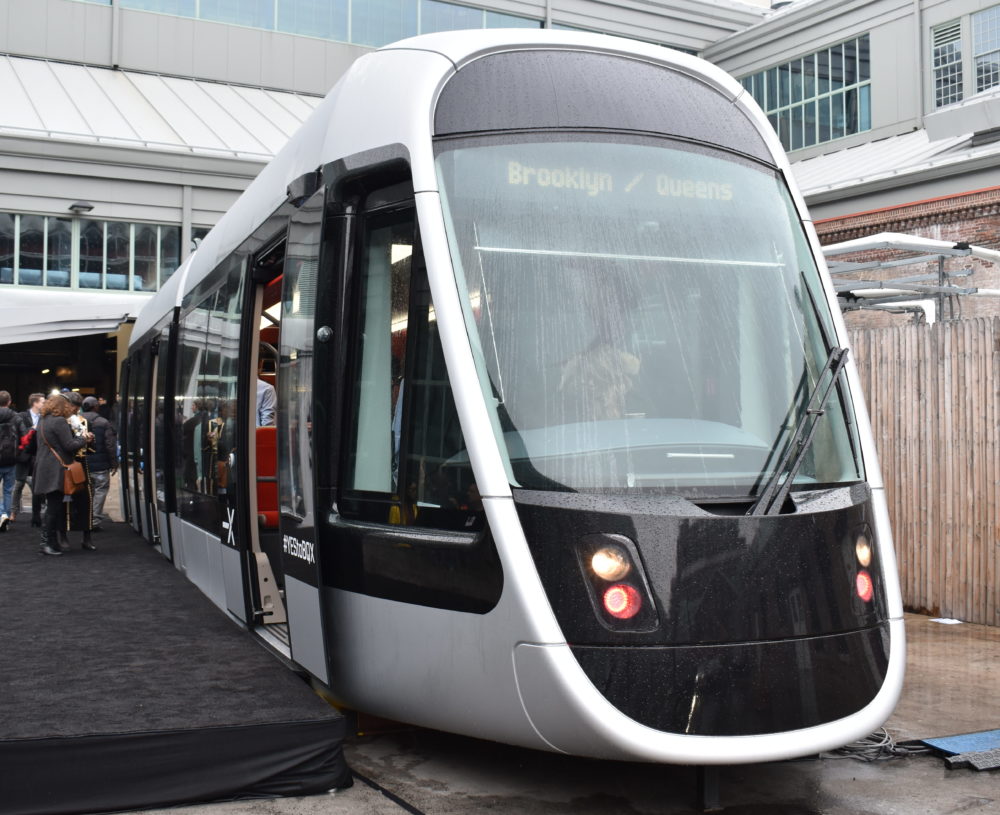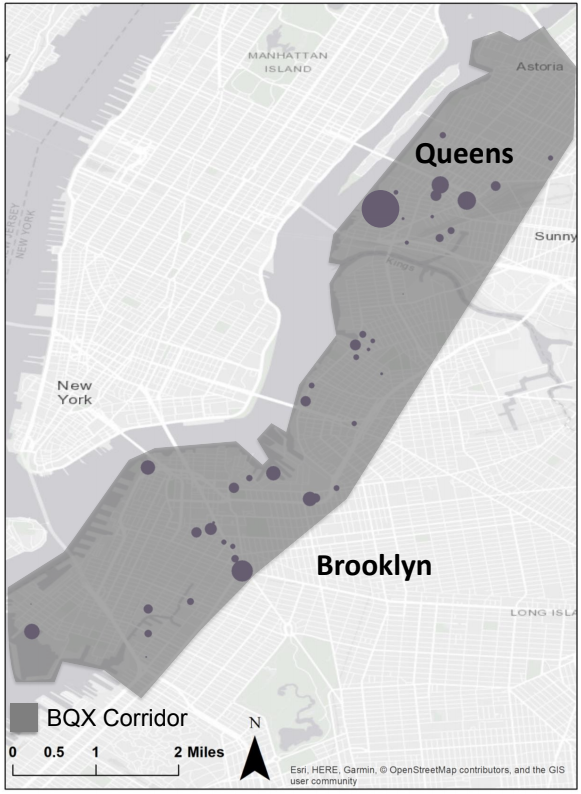Backers of the BQX Say Amazon Helps Prove Their Case
Streetcar supporters say office growth along the route will grow 50% within a decade, spurring need for more transit
A rendering of the proposed BQX passing through Downtown Brooklyn (Image courtesy of Friends of the Brooklyn Queens Connector)
The proposed Brooklyn Queens Connector (BQX) streetcar system has been moving forward at a crawl for nearly three years, sometimes even appearing to be permanently stalled. Along the way, ambitions have been tempered. In August, Mayor de Blasio announced a new plan in which the rail system would be shorter (11 miles, down from 16), pricier ($2.73 billion, up from $2.5 billion), and later (running by 2029, instead of 2024).
The progress so far, along with debate about the plan’s worthiness, hasn’t left Brooklyn and Queens residents holding their breath for that low-cost, scenic ride from Gowanus to Astoria.
But then along came Amazon and its plans to spend $2.5 billion to create an office complex for 25,000 workers in Long Island City, right along the BQX’s proposed route. Amazon’s plan has delivered a see-what-we-mean moment for BQX supporters, who contend that commercial and residential development along the Brooklyn-Queens waterfront will make the rail system an essential transit link.

A rendering of proposed BQX lines crossing between the boroughs on the Pulaski Bridge over Newtown Creek (Image courtesy of Friends of the Brooklyn Queens Connector)
Friends of the Brooklyn Queens Connector, a non-profit organized to support the streetcar proposal, issued a statement Thursday making their case: “Amazon’s decision to open a Long Island City campus underscores just how essential a role the BQX will play in delivering workers—many living in areas sorely underserved by quality mass transit—to jobs and workforce development opportunities along the corridor, which will be home to more commercial space than the downtowns of Los Angeles, Philadelphia or Boston by 2029.”
To buttress the point, the BQX group released a new analysis of future commercial-property development along the route. Office space within a mile of the BQX corridor is expected to grow by more than 50%, or 20 million sq. ft., over the next decade, said the report, conducted by the BJH Advisors real-estate firm for the BQX group. The corridor could be home to 70,000 new jobs, including the 25,000 at Amazon’s campus, as the spillover effect of Amazon’s investment stimulates the economy around it, the report said.
The BQX already has the substantial support of the business community, including the Downtown Brooklyn Partnership and the Brooklyn Chamber of Commerce. “I’m sure many Brooklynites will be commuting to Long Island City to work at Amazon,” chamber CEO Hector Batista told The Bridge for a story on the company’s arrival. “So this is actually a great time to get to work on projects like the BQX light rail in order to help us continue to grow our local talent and economy.” The BQX group is chaired by Jed Walentas, CEO of Two Trees Management, developer of the multibillion-dollar Domino Sugar factory redevelopment site in Williamsburg.

A mockup of the proposed streetcar on display a year ago in the Brooklyn Navy Yard (Photo by Steve Koepp)
Yet the project still faces major obstacles in terms of logistics and cost, including the argument that the money would be better spent on other kinds of transportation projects, like bus lines. The proposed streetcar would be built by a public-private partnership and paid for partly through the increased tax revenue collected from rising property values along the route. But it would still need about $1 billion from the federal government, the mayor’s office acknowledged this year.
Some elected officials and other opponents, however, think the BQX would be a costly distraction from focusing on improving existing transit. Earlier this month, City Council Member Carlos Menchaca, who represents Red Hook and Sunset Park, ripped the plan as a “terrible” idea in a hearing at City Hall. Speaking to transit chief Andy Byford, the council member declared: “Your visionary plan is in conflict, I think, with this idea that no one likes except for developers and can have an impact … on your plan if so much energy is going from the [government ] agencies into this plan.”
In another twist, Queens Borough President Melinda Katz, who supports the BQX plan, said earlier this month that Amazon should help pay for it. “A substantial and meaningful investment by Amazon that helps ensure the feasibility of [the BQX],” she said, “would be a fair investment into its new home and a welcome opportunity for a good corporate neighbor.”
Of course, using the Amazon development in support of the BQX begs the question of whether the Amazon deal is a good one for the city. City Council Speaker Corey Johnson and several Queens elected officials have blasted the lack of community input in the agreement, which was brokered by the governor and the mayor, and the $2 billion in public subsidies provided for it. “We got played,” declared Johnson at a public hearing on the Amazon deal.
For Brooklyn’s part, however, the borough’s civic leaders made a spirited bid to lure the so-called HQ2 and several now say that having it right next door is a lucrative consolation prize for the area’s economy.

The corridor along the proposed route of the BQX, where supporters predict rapid growth of commercial office space (Map courtesy of Friends of the Brooklyn Queens Connector)










